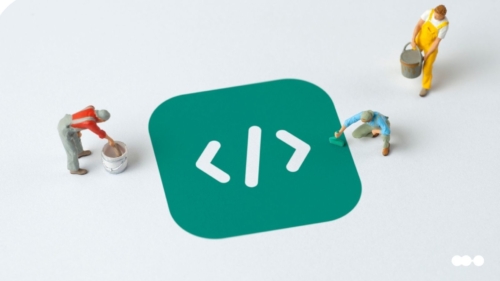
Digital change remains top of mind for business leaders. However, non-technical barriers to adopting new technology — such as cost of implementation, clear vision of business use case benefits, and working within risk-averse cultures — is a key challenge that not only prevents innovation but jeopardizes business agility and competitive advantage.
In this webinar recap, find out how Mediamark — South Africa’s largest media sales house and Pipefy and dY/dX’s mutual customer — overcame the non-technical challenges that kept it from achieving business agility.
Plus, learn more about the benefits of using low-code platforms to achieve operational efficiencies, and how to obtain stakeholder approvals and buy-in from executive leadership and IT departments with key insights from:
- Wayne Bischoff, CEO, Mediamark
- Maritsa Wessels, Business Unit Director, Mediamark
- Nevo Hadas, Managing Partner, dY/dX
- Kristen Davis, Director of Customer Solutions Marketing, Pipefy
The direction of low-code technology
The state of low-code that we see is being driven by trends, says Davis. The concept at the core of these trends is digital transformation.
“That’s a term that we’ve been hearing for a long time — probably at least 15 to 20 years or so. But what does that look like as we move into automation and innovation within business operations? How is that being changed and impacted by the new hybrid work model? And what does citizen development mean, and how is this trend part of the low-code movement?”
The ultimate goal of low-code technology adoption is to drive efficiency and agility within business operations teams. At the same time, the adoption of low-code technology is also the automation and modernization of legacy business practices and applications.
Market trends driving digital change and low-code adoption
“The trend that’s top of mind for executives today is how they can utilize technology to make
teams more productive, to increase the bottom line, and drive agility,” says Davis. “So thinking about what tasks can be automated, and how we can become more efficient to unlock bottlenecks?”
In today’s business climate, adopting technology and driving this innovation is becoming a competitive differentiator for many organizations. Not only do low-code tools bridge the need for resiliency and agility, but they address the IT backlog and satisfy the growing demands from business stakeholders by empowering business users to lead business application development.
Business units need agility. IT needs control. See how no-code delivers both with No-Code Automation: Good for Business, Great for IT
Customer use case: Mediamark’s low-code journey
Leader buy-in is crucial to adopting the technology needed for organizational digital transformation. Learn how to overcome this non-technical barrier with Mediamark’s first-hand knowledge about their journey in selecting, implementing, and utilizing low-code automation software as their key digital transformation toolkit.
Business challenges and needs before adopting digital change
As South Africa’s largest media sales house, communication is everything for Mediamark — and the slightest process interruption or delay could have a wide-reaching impact. But the current way processes were being managed and executed was not conducive to an agile business.
Prior to deciding to pursue a better way to build and manage workflows, Mediamark’s biggest obstacle was the very thing it was: an email-centric business. “Mediamark is a big business,” says Hadas of South Africa’s largest media sales house. “It’s been successful and it’s been running for 20-plus years, but, with that time, you gather processes and ways of working which would show that kind of history.”
So began the search for a solution. The team at Mediamark approached dYdX for a current-state analysis of the business from beginning to end, including partners and radio brands. “The amount of cholesterol in the system and inefficiencies was extreme,” says Bischoff. “We said, ‘Well, what will the future-state business look like? How can we automate, digitize, and liberate people from the drudgery and make them more creative and better turnaround times for our partners, brands, and clients?’”
Building the business use case
“From a financial perspective, it’s interesting because part of what we had to do is try and estimate what the impact of the system would be commercially and financially,” says Hadas. “What you have to do is take a look at the current processes that are happening in the business and cost out the processes, or try to take an average cost per person.”
To do this, Hadas and the dY/dX team identified the number of processes in the business and thought through a series of questions, like:
- How long does a process take?
- How much time is supposed to take from start to finish?
- If we redo a process, think about it differently, or automate or digitize it, how much time can we save for everyone?
With all this information gathered, it was time to build out the business case based on direct costs, direct savings, and indirect savings. “You’ve got your direct costs and other direct savings,” says Hadas. “For example, before it took me an hour to do this task, now it’s going to take me half an hour.”
For indirect savings, consider all the “invisible” benefits that can’t be calculated but make a large impact. “For example, now that the information is in the system and I’ve got transparency and accountability, how much time do I save as an organization following up on things because now it’s actually a card in a system and I can track it more easily?”
Indirect benefits are often quite extensive because you don’t think about it when you’re doing a process, says Hadas. “Simplicity and better management of tasks add a lot of value to an organization.”
What the business needed
When deciding on the business case for low-code technology, low-code wasn’t even a concept that was top of mind for Mediamark. The things that were, however, included being more efficient, minimizing the number of people needed to complete the work, and creating better outcomes. Without knowing it at the time, these were all benefits prime for low-code adoption.
“We looked at the business and could just see inefficiencies we could never work out,” says Bischoff. “Exactly where the issues were in the system because every department worked in its own siloed ways and you could understand from one department to next how things missed or disappeared in the system.”
“We had similar systems before, but it cost us a fortune to build it in,” says Wessels. “Like Wayne, said our business has a lot of moving parts and it moves very quickly. So to be able to do the maintenance on that was really difficult and it was really costly.”
In addition to wanting a solution that allowed for custom business needs to be developed easily and cost-effectively, Mediamark also needed a solution that wouldn’t require the highest level of technical expertise for deployment.
“As a whole, our technical literacy in the business is not very high,” says Wessels. “For us, our challenges weren’t IT challenges; they were real business challenges. In the process of working through our current state, redesigning our business from the bottom up, and looking at the workflows, Pipefy is a great tool for us to understand our own business better and to build something that people can actually follow and change to fit the needs of our business.”
How Mediamark improved business agility and process efficiency
“Three odd years ago, we were looking at the business,” says Bischoff. After having left the company 10 years previously and after coming back, Bischoff noticed that Mediamark had doubled the amount of staff but not double the number of actual platforms.
“Essentially, we’re throwing more and more people at the problem to deal with the needs and urgency of the markets. It wasn’t sustainable. People weren’t being liberated from all these overly complex processes and too many moving parts.”
“We needed to change the way we do business as a company and try to modernize the business, and that’s where Nevo’s team kind of opened my eyes, our eyes. There actually is a better way we can digitize the business effectively and efficiently, and there aren’t huge costs involved. That was a big worry, and this has been a whole culture change project for us and it’s made us more efficient. We’re kind of standing out within the broader group of companies as the guys to look up to, and I think it’s making us a much more agile company.”
Since the company started managing its processes with Pipefy, Mediamark has experienced an 80% improvement in customer response time and a 30% increase in efficiency
| Mediamark before low-code | Mediamark after low-code |
|---|---|
| Email-centric business | Real-time view across different divisions and business units |
| Manual processes with extensive rework | Ability for external collaborators to work within Mediamark’s processes |
| Duplicated efforts across Mediamark’s processes | Improved transparency and accountability across processes |
5 benefits to make the business case for low-code automation
Barriers to adopting technology that can improve business operations often fall on xx key concerns: cost of implementation, technology complexity, and managing change without creating additional challenges. “When we think about digital change and digital transformation, it’s really not new but the methods for managing these continue to bring challenges for leaders,” says Davis.
If any of these concerns are keeping leaders from seeing the value of investing in low-code technology, cue up these value-adding benefits to make the case for low-code adoption:
1. Low-code technology empowers business users with IT’s support
Business users need agility, but developers can’t keep up and IT teams are backlogged. “The ultimate change with low-code is that we’re empowering the business to be able to drive and own technology with IT support,” says Davis.
“IT is still very much a part of the big picture with low-code and it’s about finding that right balance. We talk about that a lot with our customers when we’re implementing Pipefy and what that landscape will look like, but, ultimately, business owners are driving these accelerated solutions. They can solve these problems independently of IT.”
2. With low-code, business owners drive accelerated solutions
Because business users are leading the development and deployment of business solutions with a toolbox of IT-sanctioned resources, the dependence on IT is limited and business agility is no longer bogged down by an ever-growing IT backlog.
3. Businesses can solve problems independent of IT
Low-code streamlines the deployment of solutions and breaks down the traditional silo of IT and development teams owning all of this technology. “End users and business users will be able to lead this concept of business application development and low-code tools like Pipefy help address the challenge that IT is facing,” says Davis.
4. Solution development can happen at 10x speed
“The changes that need to be made don’t have to go through an IT request and wait for prioritization, scoping, requirements gathering, and approval,” says Davis.
Learn more about business agility and the benefits of low-code software for businesses wanting to become more agile.
5. Low-code significantly lowers budget impact
“Business users are solving these problems independently of IT in an iterative and agile fashion and are able to develop these business solutions faster and with the low-code platform essentially,” says Davis. “With the heavy lift of a lot of development being completed, you have a significantly lower budget impact.”
ICYMI: Low-code webinar series recaps and insights
Unable to attend previous webinars? Don’t miss out on industry-leading conversations and insights. Check out our previous low-code webinar series recaps to keep informed:
Low-Code Webinar Series Recap: Why Low-Code Is Key to Digital Transformation, featuring guest speaker Carlos Cima, Vice President of Technology at SoftBank Group International.
Low-Code Webinar Series Recap: How IBM and Pipefy Navigate the Digital Landscape With Low-Code Solutions, featuring guest speaker Guilherme Novaes, Ecosystem Director at IBM Brasil.
Low-Code Webinar Series Recap: How Accenture Made Low-Code the Backbone of Digital Transformation and Innovation, featuring guest speakers Fabiano Guastella, Digital Innovation Associate Director at Accenture, and Clarison Benteo, Digital Transformation Manager at Accenture.
Low-Code Webinar Series Recap: How Lacoste and Ocean Network Express Used Pipefy to Transform Digital Experiences, featuring guest speakers Vinicius Castro, Operations and Digital Projects Manager at Lacoste, and Sergio Marques, Business Process Senior Analyst at Ocean Network Express.
Low-Code Webinar Series Recap: Dawn of the Low-Code Digital Era, featuring guest speaker John Bratincevic, Senior Analyst at Forrester.
Low-Code Webinar Series Recap: Digital Change & How to Build a Secure Foundation for Automation, featuring guest speakers Mark Pinard, Acting CMO at Pipefy, and Kwan Kim, Director of GTM Strategy at Pipefy.
Low-Code Webinar Series Recap: How Low-Code Benefits Business Agility, featuring guest speakers Thomaz Coelho, Head of Customer Success at Pipefy, and Rafael de Castro, Partner Account Manager at Pipefy.
*Some comments and quotes have been edited for clarity.







